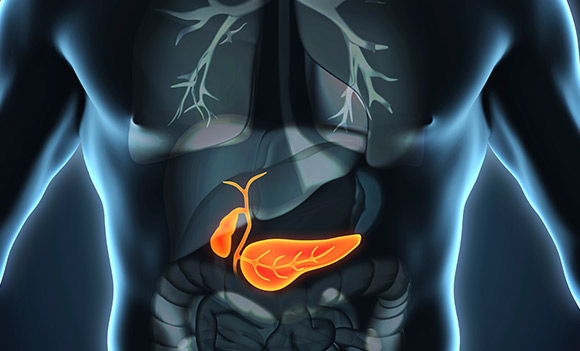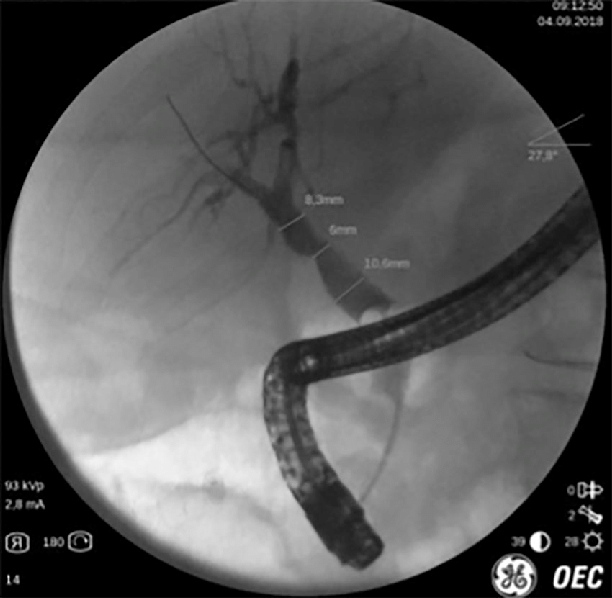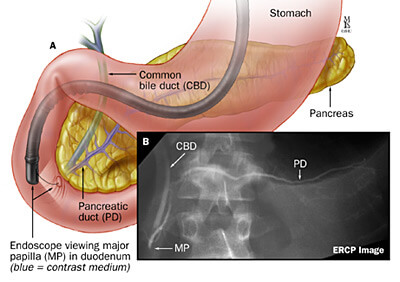ERCP is a procedure that allows your doctor to see the small tubes inside your body called the pancreatic and bile ducts. These tubes are near your stomach. They carry digestive juices from your liver and pancreas to the intestines.
For ERCP, your doctor uses a flexible lighted tube called an “endoscope.” The endoscope, or scope, is about as thick as your index finger. It goes through your mouth into your stomach and the first part of the small intestine, called the “duodenum.” Then the doctor puts a very small, flexible plastic tube through the scope and injects some dye that shows up on X-rays. This procedure allows your doctor to see the ducts and how well they are working.
Why is ERCP done?
Doctors do ERCP to find and treat problems in the pancreatic duct and bile duct. For example, you might have ERCP if your doctor suspects a disease of the pancreas or liver or a problem in the bile ducts. You might also have ERCP to find the cause of abnormal results from a blood test, ultrasound, or CT scan or to fix a problem that was identified on one of these tests. Finally, ERCP can help your doctor decide if you need surgery and if so, which surgery is best.
The most common reasons for ERCP include:
- Yellow skin or eyes (jaundice), light stool and dark urine
- Stones in the bile or pancreas duct
- A lesion or tumor in the pancreas, gallbladder, or liver
Your doctor might do ERCP before or after gallbladder surgery in specific situations. For example, they can find and remove gallstones from the bile duct and sometimes from the pancreas. ERCP can also help find cancer or non-cancerous lesions. If your bile duct is blocked, your doctor can use ERCP to put in a small plastic tube called a “stent”. This keeps the duct open and digestive juices flowing. Finally, ERCP can help find and treat problems following gallbladder surgery.
Before the Procedure / Getting Ready for ERCP
ERCP is done in a doctor’s office, clinic, or hospital. It is often done with sedation. You are not asleep during the procedure, but you take medicines called “sedatives” that make you relaxed and sleepy.
Sometimes ERCP must be done under general anesthesia, with you completely asleep. If you need general anesthesia, your doctor will discuss it with you. You might need a full physical examination. You might also need some tests to make sure you are healthy enough for surgery.
The surgeon who will do your ERCP will talk with you about the risks and benefits of the procedure. Then you will sign a form saying you understand and agree to the procedure. Your surgeon’s office will tell you what to do and avoid before surgery. The exact instructions depend on your surgeon, but here are some common things to do.
- Stop eating and drinking at the time your doctor tells you before
- The morning of your surgery, you may take medications your doctor told you are allowed. Take them with just a sip of
- You might need to stop taking certain medicines before surgery. These include blood thinners, supplements, and medicines that affect your immune system. Talk to your surgeon when you schedule your
- Tell your surgeon if you have a shellfish or iodine
You will need someone to drive you home from the procedure. You may also need someone to stay with you overnight. Ask your doctor or nurse how much help you might need.
Are there any alternatives to ERCP?
Occasionally, these problems can be addressed by radiology procedures or more advanced surgical procedures using cameras and tools by open or laparoscopic surgery, but ERCP is more commonly used because it is less invasive than surgery and it has a high rate of success.
What to Expect During the ERCP
A nurse may spray your throat with a local anesthetic before the test begins. This will numb your throat to keep you from gagging (choking) and make you more comfortable. You will receive sedative medicine through an IV. If you need general anesthesia for an ERCP, you will be completely asleep for the procedure.
You will be lying on a table for the procedure which allows x-rays to be taken. Your doctor puts the endoscope into your mouth. Then they pass it down your throat (esophagus) to the stomach and the first part of your small intestine, the duodenum. The endoscope does not affect your breathing, and you might even fall asleep during the procedure. If you do feel discomfort, it will probably be minor. For example, you might feel slightly bloated from the air your doctor uses to inflate the duodenum. You might also feel minor discomfort when your doctor injects dye for the x-rays.

ERCP usually lasts thirty minutes to an hour. Your procedure might take more or less time depending on what your doctor needs to learn and do. You can talk with your doctor ahead of time about how long it might take.
After the Procedure – What Happens after ERCP?
You stay in the procedure area for one (1) or 2 hours after your ERCP, until the sedatives wear off. Then you can have someone drive you home. You will probably want to spend the rest of the day relaxing at home. You may eat normally and take your regular medicines after the procedure, unless your doctor tells you not to. You might have a sore throat for a day or two. You might need to spend the night in the hospital after the procedure. If so, your doctor will discuss it with you.
When will I learn my ERCP results?
Your doctor will usually tell you the ERCP results on the day of the procedure. It might take several days to get all the information if your doctor took a small sample of tissue, called a biopsy. These results take longer because a laboratory needs to examine and test the tissue. Ask your doctor about the best way to learn your biopsy results.
What if I have questions?
Sedative medicines can make you forget what your doctor told you to do after the procedure. You might even forget the results. Call your doctor’s office if you have any questions or want more information.
Possible ERCP complications:
ERCP is safe when your doctor has had specific training and is experienced at doing this specialized procedure. Problems, also called complications, can happen with any medical procedure. They are rare with ERCP, but they may include the problems listed in this section.
The most common problem after ERCP is a condition called “pancreatitis.” This happens when the duct to the pancreas is irritated by the X-ray dye or small plastic tube used in ERCP. This can cause abdominal pain that gets worse instead of better after the procedure.
Other problems are possible if your doctor did any treatment during your ERCP, such as removing stones or putting in a small drain called a stent. These treatments have a small risk of causing bleeding or making a hole in the intestine or bile duct. Rarely, people who have bleeding after the procedure may need a blood transfusion to replace the lost blood, but this is rare. Another very rare risk is the risk of infection transmission from scopes.
It is important for you to know the early signs of possible complications. Call your doctor’s office immediately if you have any of the problems below after ERCP.





